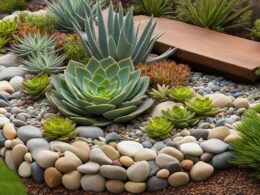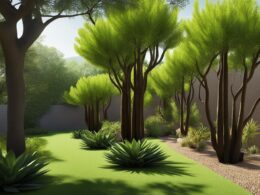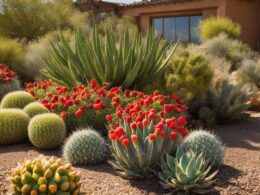Xeriscaping is a sustainable and water-conserving landscaping technique that can be applied in various climates, including dry areas like the Southwest and even the Northwest. By using gravel mulch in xeriscaping, you can minimize moisture evaporation, keep the soil cool, reduce weeds, and prevent water runoff. This guide will provide you with essential tips and techniques to master the application of gravel mulch in xeriscaping, creating a low-maintenance and environmentally sound landscape.
Key Takeaways:
- Gravel mulch is an effective tool in xeriscaping to conserve water and maintain a sustainable landscape.
- By minimizing moisture evaporation, gravel mulch keeps the soil cool and reduces the need for constant irrigation.
- Using gravel mulch inhibits weed growth, reducing the time and effort required for maintenance.
- Gravel mulch helps prevent water runoff, allowing for better water absorption and retention.
- Mastering gravel mulch application in xeriscaping allows you to create a beautiful and resilient landscape that thrives in dry conditions.
What is Xeriscaping and Why is it Important in the Northwest?
Xeriscaping is the creation of a water-conserving and environmentally sound landscape that requires minimal labor, water, fertilizer, and pesticides. While it is commonly associated with arid regions, it is equally crucial in the Northwest, where dry summer months and droughts can occur. Water scarcity is a significant concern, as evidenced by low river flows and reduced snowpack levels. By implementing xeriscaping techniques, such as using gravel mulch, homeowners can contribute to water conservation efforts and create landscapes that are resilient to drought conditions.
To understand why xeriscaping is important in the Northwest, it’s essential to consider the climate. The Northwest typically experiences cool, wet winters and warm, dry summers. During the summer months, moisture levels decrease, and water becomes scarce. This poses a challenge for maintaining lush and vibrant landscapes. Xeriscaping offers a solution by embracing the region’s natural conditions and designing landscapes that require minimal water.
With xeriscaping, you can create an outdoor environment that thrives in the Northwest climate. By using gravel mulch as a ground cover, you can reduce evaporation, retain moisture in the soil, and prevent weed growth. Gravel mulch also helps regulate soil temperature, keeping it cool during hot summer days. This allows plants to thrive even in periods of drought, reducing the need for excessive watering.
Key Benefits of Xeriscaping in the Northwest:
- Water Conservation: Xeriscaping reduces water usage by incorporating drought-tolerant plants and efficient irrigation systems.
- Environmental Sustainability: By minimizing the use of fertilizers and pesticides, xeriscaping promotes a healthier ecosystem and protects local water sources.
- Cost Savings: Xeriscaping can significantly lower water bills and maintenance costs associated with traditional landscaping.
- Increased Resilience: Xeriscaping creates landscapes that are more resistant to drought conditions, ensuring the longevity and beauty of your outdoor space.
By embracing xeriscaping and utilizing gravel mulch in the Northwest, homeowners can create beautiful, sustainable landscapes while conserving water and adapting to the region’s unique climate challenges.
Planning and Designing Your Xeriscape with Gravel Mulch
Good planning is essential when it comes to designing your xeriscape with gravel mulch. By carefully considering your outdoor living needs and conducting a thorough site analysis, you can create a landscape that is both functional and visually appealing. Here are some key factors to consider:
Site Analysis and Mapping
Before you begin designing your xeriscape, it’s important to conduct a site analysis and prepare a site map. This involves assessing factors such as sun exposure, existing vegetation, and potential sources of shade. By understanding the microclimates within your site, you can make informed decisions about where to place different elements of your xeriscape design.
Incorporating Raised Beds and Soil Amendment
Raised beds can be a valuable addition to your xeriscape design, particularly when it comes to improving drainage and making maintenance easier. By incorporating raised beds, you can create separate areas for different types of plants, each with their own specific soil requirements. Before installing irrigation systems, it’s important to amend the soil with organic material to enhance its health and water-holding capacity.
Using Gravel Mulch for Ground Cover
Gravel mulch is a popular choice for covering open ground in xeriscapes. It serves multiple purposes, including reducing evaporation, inhibiting weed growth, and enhancing the overall aesthetics of your landscape. When using gravel mulch, be sure to choose a size and color that complements your overall design scheme.
Creating a Functional and Beautiful Landscape
When planning and designing your xeriscape, it’s important to strike a balance between functionality and beauty. Consider incorporating elements such as seating areas, paths, and focal points to create an inviting space. Additionally, think about the views you want to enhance or screen, and utilize plants, trees, or fencing to achieve your desired effect.
| Element | Considerations |
|---|---|
| Seating Areas | Choose comfortable and durable seating options that can withstand the elements. |
| Paths | Create well-defined paths that are easy to navigate and blend with the overall design. |
| Focal Points | Introduce eye-catching features such as sculptures, water features, or unique plant specimens. |
By carefully planning and designing your xeriscape with gravel mulch, you can create a beautiful, low-maintenance landscape that is both environmentally friendly and functional for your outdoor living needs.
Selecting the Right Plants for Your Xeriscape with Gravel Mulch
When creating a xeriscape with gravel mulch, selecting the right plants is crucial to ensure a beautiful and sustainable landscape. By choosing plants that are well-suited to your local climate and require minimal water, you can create an eco-friendly garden that thrives even in arid conditions. Consider the following factors when selecting plants for your xeriscape project.
Plant Selection Criteria
1. Adaptability: Look for plants that are native to your region or those that have proven to adapt well to your climate. Native plants are often more resistant to local pests and diseases and require less water and maintenance.
2. Water Efficiency: Choose plants that have low water requirements and are drought-tolerant. These plants have adapted to survive in arid conditions and can thrive with minimal irrigation.
3. Growth Habit: Consider the mature size and growth habit of the plants you choose. Avoid selecting plants that will outgrow their space and require frequent pruning or become overcrowded.
4. Aesthetic Qualities: Select plants that complement your desired landscape design. Consider factors such as color, texture, and flowering periods to create an appealing and visually diverse garden.
Recommended Xeriscape Plants
Here are some popular and well-suited plants for xeriscapes with gravel mulch:
- Lavender: Known for its lovely fragrance and beautiful purple flowers, lavender is a drought-tolerant plant that adds a touch of elegance to any xeriscape garden.
- Yarrow: With its feathery foliage and clusters of colorful flowers, yarrow is a tough and resilient plant that attracts beneficial insects to the garden.
- Agave: This succulent plant is known for its striking rosette shape and low water requirements. It adds a unique architectural element to xeriscape designs.
- Red Hot Poker: With its vibrant spikes of red, orange, and yellow flowers, red hot poker adds a splash of color to xeriscape gardens and attracts hummingbirds.
| Plant | Water Requirements | Height | Flowering Period |
|---|---|---|---|
| Lavender | Low | 1-3 feet | Summer |
| Yarrow | Low | 1-3 feet | Summer |
| Agave | Low | 1-5 feet | Varies by species |
| Red Hot Poker | Low | 2-5 feet | Summer |
Remember to group plants with similar water and light requirements together to create efficient watering zones within your xeriscape. Additionally, the use of gravel mulch around your plants helps conserve moisture and suppress weed growth. By carefully selecting and grouping plants, you can create a xeriscape garden that is not only visually appealing but also requires minimal water and maintenance.
Watering and Irrigation Strategies in Xeriscaping with Gravel Mulch
In xeriscaping, efficient watering is key to conserving water and maintaining a healthy landscape. By implementing proper watering and irrigation strategies, you can ensure that your xeriscape thrives while minimizing water waste. One effective technique is drip irrigation, which delivers water directly to the roots of plants, reducing evaporation and runoff. This method saves water by providing targeted hydration to plants only where it is needed most.
When setting up a drip irrigation system, it is essential to design it according to the specific water requirements of your plants. Group plants with similar water needs together, creating hydrozones that allow for different irrigation schedules. For example, native plants and drought-tolerant species may require less water than thirstier varieties. By dividing your landscape into separate irrigation circuits for lawn areas and planting beds, you can tailor the watering schedule to each zone’s specific needs, avoiding overwatering or underwatering.
Another important consideration is timing. Watering during the cooler parts of the day, such as early morning or late evening, reduces evaporation and ensures that the water reaches the plant roots effectively. Avoid watering during the hottest hours of the day, as the water is more likely to evaporate before it can penetrate the soil. Additionally, applying a layer of gravel mulch around your plants helps slow down water flow, prevents runoff, and keeps the soil moist for longer periods, reducing the frequency of watering.
Benefits of Efficient Watering
- Conserves water resources: By using efficient watering techniques, you can significantly reduce water waste and contribute to water conservation efforts. This is particularly important in regions prone to drought and water scarcity.
- Promotes plant health: Deep and infrequent watering encourages plants to develop deep root systems, making them more resilient to drought and environmental stress. Consistent moisture levels also help prevent diseases caused by overwatering, such as root rot.
- Reduces maintenance: Efficient watering minimizes the need for frequent irrigation, reducing the time, effort, and cost associated with maintaining your xeriscape. This makes it a practical and sustainable choice for homeowners.
By implementing efficient watering practices, such as drip irrigation and proper timing, you can ensure the long-term success of your xeriscape while conserving water resources and promoting a healthy and vibrant landscape.
Maintaining Your Xeriscape with Gravel Mulch
Once your xeriscape with gravel mulch is established, it requires minimal maintenance to keep it thriving. By following a few simple steps, you can ensure that your landscape remains beautiful, weed-free, and sustainable for years to come.
One of the key aspects of xeriscape maintenance is weed control. While the application of gravel mulch helps suppress weed growth, some weeds may still emerge. Regularly inspect your xeriscape and remove any weeds as they appear. Hand weeding is an effective and environmentally friendly method. Alternatively, you can use natural weed control products, such as Bioweed, to eliminate weeds without the use of harmful pesticides.
In addition to weed control, it’s important to cover open ground with a layer of organic mulch. Bark or wood chips are excellent choices as they not only prevent weed growth but also help reduce evaporation, retain moisture in the soil, and regulate soil temperature. Apply a thick layer of mulch, around 2-3 inches deep, to maximize its effectiveness.
Sustainable gardening practices should also be embraced in xeriscape maintenance. Avoid overwatering your plants, as it can lead to root rot and other water-related issues. Instead, water deeply and infrequently, allowing the soil to dry out between waterings. This encourages deep root growth and helps the plants become more drought-tolerant over time. Use drip irrigation systems, which deliver water directly to the plant’s root zone, minimizing water waste and evaporation.
By diligently maintaining your xeriscape with gravel mulch, you can enjoy a low-maintenance, sustainable garden that conserves water, reduces weed growth, and enhances the overall beauty of your landscape.
Tips for maintaining your xeriscape with gravel mulch:
- Regularly inspect and remove weeds by hand or with natural weed control products like Bioweed.
- Cover open ground with organic mulch, such as bark or wood chips, to prevent weed growth and conserve moisture.
- Water deeply and infrequently, allowing the soil to dry out between waterings, to encourage deep root growth and drought tolerance.
- Consider using drip irrigation systems to minimize water waste and evaporation.
- Embrace sustainable gardening practices to create a self-sufficient ecosystem in your xeriscape.
Can Different Types of Mulch be Used in Xeriscaping?
When it comes to xeriscaping, choosing the right mulch options for xeric landscapes is crucial. Different types of mulch, such as gravel, wood chips, or straw, can be used to conserve water and suppress weeds in xeriscaping. Each type has its own benefits and can contribute to a successful xeric landscape.
Conclusion
Xeriscaping with gravel mulch offers a multitude of benefits, including water conservation, reduced maintenance, and the creation of a sustainable landscape. By embracing the principles of xeriscape design, selecting appropriate plants, implementing efficient watering strategies, and maintaining your xeriscape, you can master the application of gravel mulch in xeriscaping and create a beautiful, low-maintenance garden that withstands dry conditions.
One of the key advantages of gravel mulch application in xeriscaping is water conservation. By using gravel mulch, you can significantly minimize moisture evaporation, keeping the soil cool and moist for longer periods. This not only reduces water consumption but also helps in preventing water runoff, a crucial factor in water-scarce regions.
Furthermore, gravel mulch acts as a natural weed barrier, reducing the need for herbicides and manual weeding. Its use in xeriscaping not only keeps the landscape looking tidy and well-maintained but also saves you time and effort in garden maintenance.
In conclusion, by incorporating gravel mulch in your xeriscape, you not only contribute to water conservation efforts but also create a visually appealing, eco-friendly outdoor space. So, embrace the concept of xeriscaping, apply gravel mulch intelligently, and enjoy the long-term benefits of water-efficient and sustainable landscaping.














